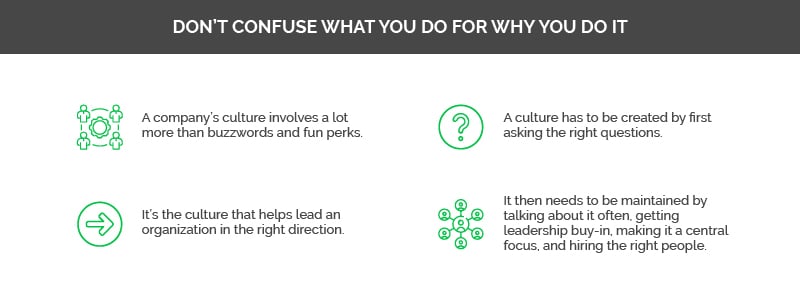How to Create – and Maintain – a Strong Company Culture

Whether your company’s culture was created by design or by accident, it could be time to make some changes.

You know those framed posters you see in a lot of offices? The ones with buzzwords like “Motivation” or “Persistence” and images of people climbing mountains? That’s not culture. Foosball tables, unlimited donuts, and wacky hat days? Those are fun, but they’re not culture either.
Certain sentiments or activities may be important to an organization, but its culture has to involve much more than wall art and foosball if the company wants to survive and thrive. This guide covers what you should know about culture, how to create a strong one, and why it matters.
So, what is culture and why is it so important?
Your culture is what your company represents and stands for. It thus needs to encompass your core values and act as a guiding light for what your company does now and where it wants to go in the future.
The Harvard Business Review says that “When properly aligned with personal values, drives, and needs, culture can unleash tremendous amounts of energy toward a shared purpose and foster an organization’s capacity to thrive.” It also discusses the four key characteristics of a company culture:
- It’s shared – Culture involves shared team behaviors. It’s not just about one person or the average of certain traits.
- It’s all encompassing – Culture has to be part of the fabric of an organization. In addition to manifesting itself in what people do, it also needs to be prevalent in their motivations.
- It (eventually) goes without saying – While it’s important to talk about a company’s culture, the basic tenets of it should unconsciously influence all actions over time.
- It has long-term influence – A culture will continue to impact an organization and its people for a very long time, and it will become resistant to change – which could be a good or a bad thing.
How to build a robust culture – or revamp the one you have
When you first started your company, there’s a good chance that you didn’t give a ton of thought to its culture. You were probably very focused on products or services, marketing, funding, and a thousand other things. The truth is that your culture may have shaped itself, whether you were aware of it or not. This could’ve happened based on the things you and any other company leaders said and did, how you approached problems, and the types of people you hired.
If now you suddenly realize that you were never really active in building the culture, it’s time to do something about that. Perhaps your business has grown and you’ve lost sight of the culture you once created. Maybe it’s time for a pivot. Whatever the case, it’s never too late for much-needed changes.
Start by asking questions
The first step is to ask basic yet very essential questions. For example:
- Why does your company exist?
- Why do you do what you do?
- What do you (and your team) believe in?
- Which values and beliefs are most important?
Without clear answers, you can’t build a clear culture.
“In the absence of answers to these most basic questions, we didn’t know whether we were really aligned,” Michael Monteiro, CEO of property management software company Buildium, noted in an interview. “That was fine in the early years when we were in survival mode, but as time went on, our employees increasingly wanted to know where we were going as a company.”
The fun stuff and the perks you offer your staff are great, but your staff needs to fully understand what you feel about your company, its direction, and how they fit into that plan.
Talk about it often
Your culture should become so ingrained that you don’t have to discuss it, but that won’t happen overnight. You need to start by talking about it a lot so it’s top-of-mind for everyone and directs your decisions. Have a mission and vision statement you can post around your workspaces. Read it aloud before your team meetings. Have open discussions about the mission, vision, and culture so you can see where you might be falling short of being transparent.
Make corrections
Early on, there may be some missteps. It’s possible that actions will be taken that don’t reflect your culture or even go against your core beliefs. It’s important to rectify this as soon as possible and put measures in place to prevent it from happening in the future. Learn from these mistakes.
Live it
Remember that wall art we mentioned earlier? It’s all too easy to put sayings and quotes up and just say “do this” and walk away. As leadership goes, so goes an organization. This means that if a team sees the people in charge not walking the walk with the culture, they’ll be much less likely to buy in.
Don’t forget it
The “why you do what you do” should be a compass for a company. It’s vital to think about your purpose whenever an issue arises and you’re unsure how to proceed, as this should be able to point you in the right direction.
Hire people that fit it
Never underestimate the importance of cultural fit for your organization. Newer companies looking to hire typically focus on skills and experience rather than whether the person is right for the culture (or vice versa). The wrong hire can be very costly, though, so assessing their fit during the interview and vetting process is vital. Asking the right questions can provide a lot of good insight, as can working with experts who understand the hiring and training process.
Building a culture that you’re proud of is very rewarding, but it does take some work. If you need help finding the right salespeople to create and reinforce it, MetaGrowth Ventures can help. We’ll help you staff a goal-crushing team, train them to meet and exceed your standards, and track their progress to ensure they stay top-level talent for years to come. Get in touch with our team to get started.
Written by
Joe Arioto
